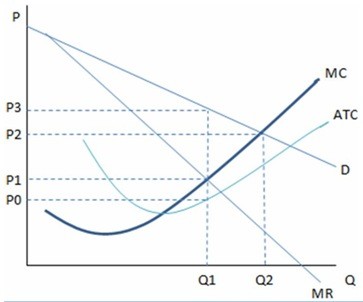The loss of the profit motive by a publicly-owned natural monopoly causes which of the following to happen?
A. Increased motivation to cut costs
B. Increased pressure from the public to cut costs
C. Increased pressure from the public to turn a profit
D. Decreased incentive to improve efficiency
Answer: D
You might also like to view...
Which of the following algebraic forms for a demand curve yields an isoelastic demand curve?
A) Q = a - b log(P) + c log(I) B) Q = a - bP + cI C) log(Q) = a - b log(P) + c log(I) D) log(Q) = bP + cI
This graph shows the cost and revenue curves faced by a monopoly.  According the graph shown, the profit-maximizing decision of the monopolist would be:
According the graph shown, the profit-maximizing decision of the monopolist would be:
A. Q1, P1. B. Q2, P2. C. Q1, P3. D. Q1, P2.
Given that there are significant economies of scale involved in making flat screen television sets, the cost of manufacturing a flat screen television set most likely will:
A. rise as the industry matures. B. fall as the industry matures. C. rise whether the industry matures or not. D. remain the same as the industry matures.
If the GDP gap is negative, then:
A. the inflation rate is rising. B. actual GDP is less than potential GDP. C. potential GDP is less than actual GDP. D. the unemployment rate is falling.